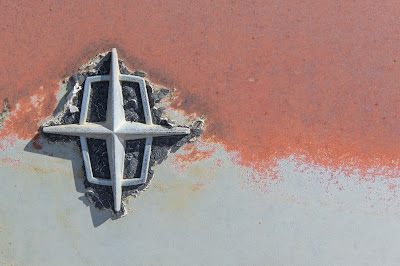Arroyos are natural channels for water that occasionally fill and flow after significant rainfall, but otherwise remain empty. Arroyos are common in New Mexico, and in an urban area such as Albuquerque, where roads, houses, and businesses have been built, management of arroyo floodwaters is crucial to preserving property and structures.
One of Albuquerque's major arroyos is Bear Canyon Arroyo, which originates in the foothills of the Sandia Mountains east of Albuquerque and runs through the northeast part of the city. To prevent significant flooding along the arroyo, a catch basin and dam have been built right next to a major street.
 |
| Image courtesy of Google Earth |
The dam is probably 100 yards across and 30 feet high, and the spillway (the downstream side of the dam) has an array of massive concrete blocks designed to disperse the flow of any water that might overflow the dam. Here's what the spillway side of the dam looks like from street level:
Fans of Breaking Bad may remember this location from Season 5, Episode 11, where Jesse Pinkman waits to be picked up to leave Albuquerque:
Notwithstanding their utilitarian purpose and their service as a location for Breaking Bad, the spillway and its tombstone-like monoliths make for a visually interesting setting, ripe with photographic possibilities.
Last Thursday evening I happened to be in the neighborhood of the dam around sunset, and I had brought my camera in case the light and/or clouds were interesting. I wasn't disappointed.
The spillway side of the dam faces west. The sunset itself was pretty good . . .
. . . but the best part was the pink-gold reflected light it was throwing onto the spillway monoliths and the clouds in the eastern sky above:
And, as luck (or the Universe) would have it, for photographic interest there was a woman at the top row of monoliths watching the sunset:
So she and the monoliths and the sky became my focus as the sunlight faded:
Fifteen minutes after I started shooting, the light was gone:
If you would like to see these (and more) images in a larger format, please visit my photography website, Todos Juntos Photography, by clicking here.
Enjoy!






















































